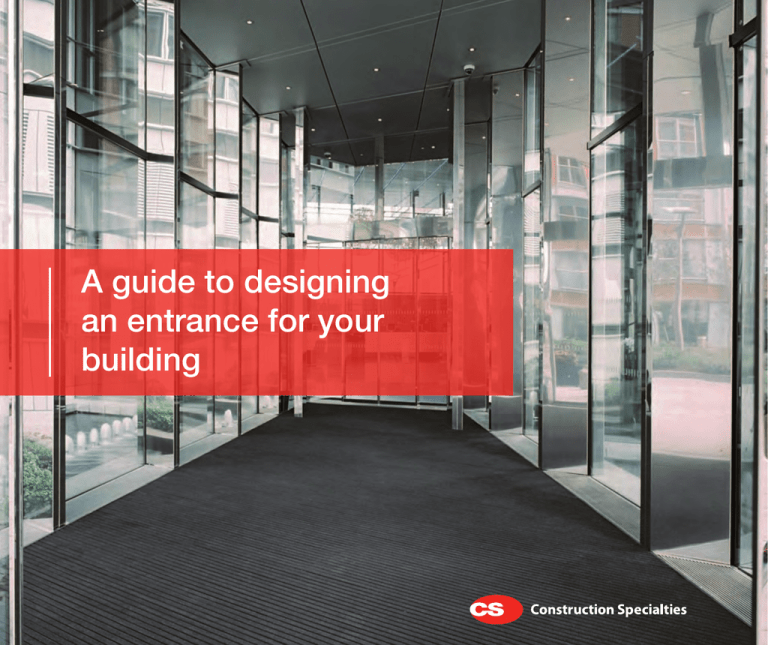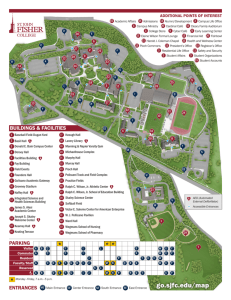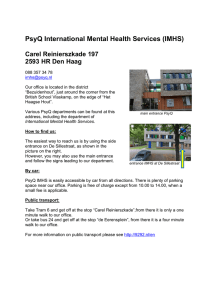A guide to designing an entrance for your building
advertisement

A guide to designing an entrance for your building About the Authors Founded in the United States, C/S has been a global manufacturer and supplier of a range of specialist building products for over 60 years. Operating through 22 offices world wide, with key manufacturing locations or sales offices in most European countries. Employing more than 2000 people around the world C/S have the skills and the knowledge to help you with your building. With years of building protection experience under our collective belts, we’ve distilled our knowledge into this compact guide to designing an entrance for your building. In addition to our experience, we’ve also included recommendations from the Health & Safety Executive (HSE) as well as details of current legislation applicable to entrances and entrance flooring systems. So lets get started... Contents Page Facts & Figures 4-5 Self Closing Doors 6 Rotating Doors 7 Secondary Entrances 8 Canopies 9 Entrance Mats 10 Positioning Entrance Mats 11 Supplementary Mats 12 Summary 13 www.c-sgroup.co.uk mm of Rainfaill p/a Facts & Figures Scotland wales ireland england High levels of rainfall lead to an increased risk of slipping accidents within UK buildings. It is therefore essential that the proper measures are in place at the entrance to prevent this from happening. Slipping accidents count for 1 in 3 major injuries within the UK. 50% 50% of all reported accidents to members of the public are slipping accidents, this ebook will go some way to show how this number can be reduced with properly designed entrances. £133 million cost to the NHS every year All statistics sourced from Health and Safety Executive (HSE) Online. www.c-sgroup.co.uk Self Closing Doors Well designed entrances often have self closing doors, helping to keep inclement weather out, protecting entrance mats and floor surfaces, and reducing the amount of building heat loss. It is also worth noting that under floor heating and heat curtains over doorways can often speed up the drying time of wet mats and floors, and can contribute to a well designed entrance. Care must be taken to ensure automatic doors aren’t too sensitive, being triggered by passers-by and potentially allowing rain to be blown-in on busy days. Rotating Doors Rotating doors force pedestrians to take several footsteps on the entrance matting within the door. This provides an opportunity to remove water from shoes on wet days, and reduces the amount of water tracked into the building. Some rotating doors can be a problem for people carrying bags and deliveries, wheelchair users and people with mobility problems, so it is important to ensure that secondary doors are installed for alternative access. (See next page for more info) www.c-sgroup.co.uk Secondary Entrances Secondary entrances often aren’t self closing and frequently have inadequate entrance matting, which leads to water getting into the building, causing a slip hazard. Secondary entrances should be designed to effectively stop water getting into the building, using effective entrance matting and some of the other design methods mentioned in this ebook. Canopies Canopies can play a key role in protecting building entrances from inclement weather, reducing the ingress of water. When designing a good canopy you should consider: • The height - If it’s too high rain or snow may be blown under it towards the doors • The size - It needs to extend far enough away from the building to provinde an effective rain shadow for the entrance • The orientation - It should provide effective shelter from prevailing winds. Canopies have an important function, preventing water getting into the building. When making a design statement out of a canopy, remember, it still needs to perform its original function www.c-sgroup.co.uk Entrance Mats Entrance mats are one of the main barriers preventing dirt and water from being walked in and getting onto the floor of a building. Entrance mats are often primarily installed to protect the surface finish of the floor. To prevent slips, entrance mats need to be good at removing water from shoes. It takes several footfalls with each foot to effectively dry a pedestrin’s shoes. On average C/S recommends 8-10 footfalls, roughly 6 metres of entrance matting. Wet footprints beyond the matting are a warning sign, and indicate that the mat is either not long enough, not absorbent enough or can’t cope with the amount of foot traffic. Effective entrance mats should: be good at retaining water be quick drying be fungal and bacteria resistant cope with push chairs & rolling loads be regularly cleaned be kept in good condition It is also important that there is a clear colour contrast between the entrance mat and the surround Positioning Entrance Mats Positioning matting as close to the entrance as possible helps to reduce the chance of a slip and immediately tackles shoe born dirt and water. If an entrance mat is positioned correctly, everyone that enters the building should step directly onto the mat and should walk across it for several paces, before stepping onto the entrance floor. To prevent trips, entrance mats should ideally be fixed, or sited in a mat-well. This allows the mat to be flush with the floor and prevents mats from creeping. www.c-sgroup.co.uk Supplementary Mats There are times when supplementary matting will be used to stop water getting onto a floor, for example, at secondary doorways or beyond entrance matting that is proving ineffective. Supplementary matting needs to have the same good features as fixed matting, and should not move when stepped on. It is important that they don’t lose their shape, curl or ruck as they can create a slip risk. When using supplementary matting, position it up against the original fixed matting, ensuring there are no gaps. If used as a standalone mat at an entrance, position it as close to the doorway as possible, again ensuring no gaps and that it is fixed securely using an adhesive or tackifier. It is important to note that loose mats or “throw down” mats can introduce a range of hazards, and can create a barrier to entry which is against DDA compliance so C/S recommends fixing any supplementary matting using an adhesive of tackifier. Supplementary matting should be considered a temporary fix, it is recommended to improve the entrance design at the first opportunity. To Summarise • Water tracked into a building can cause a slip hazard. By considering slips at the design stage you can prevent accidents and the need for expensive modifications later • As floors at entrances are likely to get wet, specify flooring that has a low slip risk when wet. • Effective entrance matting, canopies & rotating doors can all help to minimise the amount of water brought into a building • For mats to remove water from shoes, they need to be absorbent, long enough for a pedestrian to walk on them for several steps, and be kept in good condition. • Under floor heating and heat curtains over doorways can speed up the drying time of wet mats and floors. www.c-sgroup.co.uk Found our ebook useful? Why not share it with your colleagues & friends... share this ebook www.c-sgroup.co.uk We have more great content on our website: www.c-sgroup.co.uk and on our blog info.c-sgroup.co.uk If you have any questions or comments we’d love to hear from you, please get in touch via: Phone: (+44) 01296 652800 Email: enquiries@c-sgroup.co.uk Twitter: @csgroupnews Facebook: www.c-sgroup.co.uk/facebook

